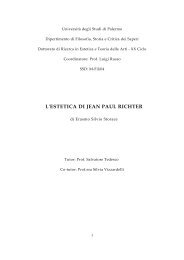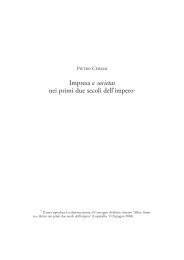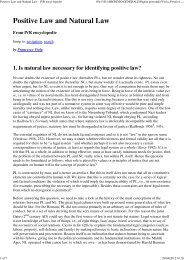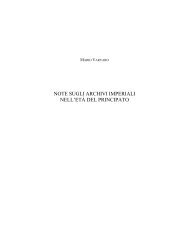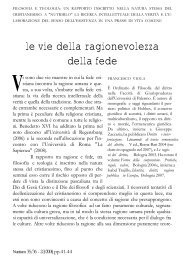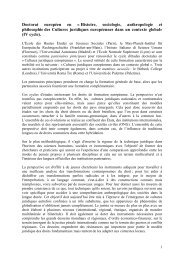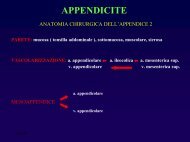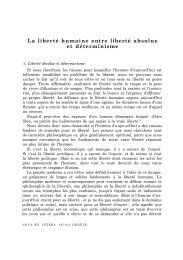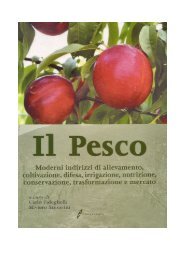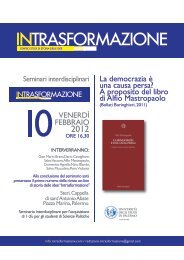M. VARVARO, Gai 4.163 e la struttura della formula arbitraria nell ...
M. VARVARO, Gai 4.163 e la struttura della formula arbitraria nell ...
M. VARVARO, Gai 4.163 e la struttura della formula arbitraria nell ...
Create successful ePaper yourself
Turn your PDF publications into a flip-book with our unique Google optimized e-Paper software.
M. Varvaro, <strong>Gai</strong> <strong>4.163</strong> e <strong>la</strong> <strong>struttura</strong> del<strong>la</strong> formu<strong>la</strong> <strong>arbitraria</strong> [p. 705-734]<br />
eventi precedenti o coevi al momento del<strong>la</strong> litis contestatio, 76 avrebbe<br />
potuto essere esaminata, talora, anche prima di quel<strong>la</strong> enunciata nel<strong>la</strong><br />
intentio (come nel caso delle eccezioni pregiudiziali), e, se verificata,<br />
avrebbe portato all’assoluzione del convenuto senza che il giudice<br />
neppure considerasse quanto dedotto nel<strong>la</strong> intentio. 77 La condizione<br />
contemp<strong>la</strong>ta nel<strong>la</strong> c<strong>la</strong>uso<strong>la</strong> <strong>arbitraria</strong>, che era espressa al futuro (restituetur<br />
o exhibebitur ), riguardava invece un evento successivo al<strong>la</strong> litis<br />
contestatio, 78 e poteva essere valutata ai fini dell’assoluzione, come si è<br />
osservato, so<strong>la</strong>mente dopo che il giudice avesse esaminato <strong>la</strong> sussistenza<br />
del<strong>la</strong> condizione enunciata nel<strong>la</strong> intentio.<br />
Anche per questa ragione, dunque, si può ritenere che, a differenza<br />
di quanto creduto da Lenel e da Arangio Ruiz, <strong>la</strong> conceptio uerborum<br />
del<strong>la</strong> formu<strong>la</strong> <strong>arbitraria</strong> di cui si discorre in <strong>Gai</strong> <strong>4.163</strong> seguisse un<br />
andamento che, come quello dei programmi di giudizio di tutte le<br />
altre formule arbitrarie, si artico<strong>la</strong>sse secondo uno schema in cui a una<br />
condizione introdotta nel<strong>la</strong> intentio dalle parole ‘SI PARET’ 79 si<br />
connettesse quel<strong>la</strong> espressa nel<strong>la</strong> c<strong>la</strong>uso<strong>la</strong> <strong>arbitraria</strong>, cui poi seguiva <strong>la</strong><br />
condemnatio.<br />
Benché quel che si legge in <strong>Gai</strong> 4.165 potrebbe fornire uno spunto<br />
per ipotizzare che tale c<strong>la</strong>uso<strong>la</strong> fosse espressa in una proposizione<br />
introdotta da ‘NISI’, 80 appare preferibile pensare che, a differenza da<br />
quanto immaginato da Rudorff, essa fosse introdotta dal<strong>la</strong> congiun-<br />
—————————<br />
76 Si consideri ancora una volta, a titolo di esempio, il testo del<strong>la</strong> exceptio doli mali<br />
riferito in <strong>Gai</strong> 4.119 [KRUEGER-STUDEMUND 7 , 186]: ...SI IN EA RE NIHIL DOLO MALO A.<br />
AGERII FACTVM SIT NEQVE FIAT.<br />
77 In tal senso si veda quanto osservato in M. <strong>VARVARO</strong>, Ricerche sul<strong>la</strong> praescriptio, cit.<br />
(nt. 4), 63-67.<br />
78 Cfr. E. LEVY, Zur Lehre, cit. (nt. 9), 70 (= Gesammelte Schriften, I, cit., 368); M.<br />
KASER, Das römische Zivilprozessrecht 2 , cit. (nt. 3), 337; M. MARRONE, Istituzioni 3 , cit.<br />
(nt. 3), 95, nt. 77.<br />
79 Preceduta da una nomina dell’arbitro che avrebbe dovuto decidere <strong>la</strong> controversia,<br />
e che forse in età più antica, prima che si obliterasse <strong>la</strong> distinzione tecnica fra arbiter e<br />
iudex, per cui v. G. PUGLIESE, Il processo civile romano, II, 1, cit. (nt. 56), 192-194,<br />
doveva essere ancora enunciata nei termini: ‘Lucius Titius arbiter esto ’.<br />
80 <strong>Gai</strong> 4.165 [KRUEGER-STUDEMUND 7 , 196]: ...nisi ea res exhibeatur aut restituatur; v.<br />
anche <strong>Gai</strong> 4.166a [KRUEGER-STUDEMUND 7 , 198]: ...nisi restituat mihi possessionem rell.<br />
Sul valore di ‘nisi ’ e sulle differenze rispetto a ‘si non ’ v. J.B. HOFMANN-A. SZANTYR,<br />
Lateinische Syntax und Stilistik, cit. (nt. 73), 667.<br />
AUPA 55/2012 733



